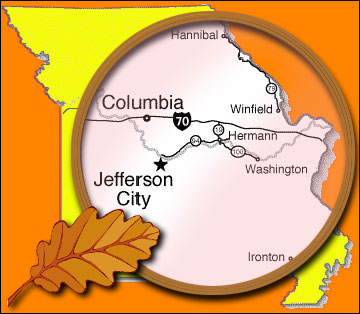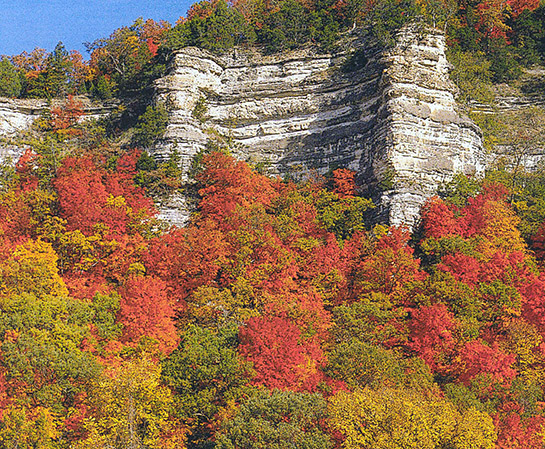
The spectacular parade of colors associated with the Indian summer days of autumn is created by a complicated series of interactions involving pigments, sunlight, moisture, chemicals, hormones, temperature, length of daylight, growing location and genetic traits. A precise clockwork within the leaf cells sets the forests of Missouri ablaze when early fall days are bright and cool, and nights are chilly but not freezing.
Several central Missouri highways have reputations for being particularly beautiful autumn drives:
- Highway 19 between I-70 and Hermann
- Highway 94 north of the Missouri River between Jefferson City and Hermann,
- Highway 100 south of the Missouri River between Hermann and Washington.
A favorite route for fall foliage watching in eastern Missouri is Highway 79 along the Mississippi River between Winfield and Hannibal.

Good colors can also be found on the bluffs along the Missouri River Trail in the central part of the state around Columbia and the Piedmont area around Ironton (Figure 1).
The leaves of the growing season are green because of the formation of chlorophyll, a pigment found in minute leaf structures called plastids. Chlorophyll is the change agent for food making in green plants. These green pigments use energy from sunlight, carbon dioxide from air, and water from the tree itself to produce simple sugars that feed the tree in a delicate process known as photosynthesis.
Yellow and orange pigments called carotenoids are also present in the leaves during the warm weather of the growing season, but are "masked" by the greater amounts of the green pigments (Figure 2). Autumn's dropping temperatures and decreasing day length stop the production of new green pigments and cause existing chlorophyll to degrade at an accelerated rate. The yellow pigments are then "unmasked" as the green pigments disappear, accounting for the brilliant coloration of Missouri hardwood species such as hickories, birches, cottonwood, sassafras, poplars and hackberry.
These autumn environmental stimuli also cause the leaves to form a hormone called abscisic acid. The abscisic acid induces the plant to form weak layers of new cells at the base of the leaf stem. These abscission zones eventually break apart from wind or other physical disturbances, often causing the leaf to fall before the yellow and red pigments have deteriorated.

The pigments responsible for the vivid red and purple autumn colors of persimmons, dogwoods, maples, sumacs, sweetgums and ashes come from another group of cell pigments called anthocyanins (Figure 2). Anthocyanins develop in the sap of leaf cells in late summer and are stimulated by lowering temperatures and high light levels. If the tree's sap is acidic, the leaves become red; alkaline sap causes purple coloration. Anthocyanin formation in the leaf depends on a simultaneous increase of sugars in the presence of bright light and a decreasing level of phosphate caused by the chemical moving out of the leaf into the stem. Mild drought conditions also stimulate production of the red pigments.
Carotenoids and anthocyanins often combine in leaves to give the deep oranges, fiery reds, and bronzes typical of many hardwood species. Brown autumn leaf color of oaks and beech is due to the presence of the brownish tannin compounds in combination with the carotenoids.
Several environmental factors can diminish the fall foliage colors. Very warm weather conditions encourage late season chlorophyll production and vegetative growth, which discourages initiation of autumn colors. An early frost before abscission kills the leaf before the pigments reach their maximum development, causing it to simply shrivel and fall to the ground. Long periods of wet, cloudy weather in fall produce a drab coloration because of low light intensity.
To summarize, cool but not freezing temperatures, mild late-season drought and sunny days are necessary ingredients for creating the brightest fall colors of the Missouri woodlands.
The fall colors displayed by 32 common deciduous trees native to Missouri are listed below.
Fall colors for common native Missouri deciduous trees
- Ash, green
Fraxinus pennsylvanica
Yellow - Ash, white
Fraxinus americana
Orange/purple - Basswood, American
Tilia americana
Brown/yellow - Birch, river
Betula nigra
Yellow - Bladdernut, American
Staphylea trifolice
Yellow - Buckeye, Ohio
Aesculus glabra
Yellow - Cherry, black
Prunus serotina
Yellow - Dogwood
Cornus florida
Red/purple - Elm, American
Ulmus americana
Yellow - Hackberry
Celtis occidentalis
Yellow - Hawthorn, downy
Crataegus mollis
Red - Hazelnut
Corylus americana
Yellow - Hickory, bitternut
Carya cordiformis
Yellow - Hickory, shagbark
Carya ovata
Orange/yellow - Honeylocust
Gleditsia triacanthas
Yellow - Ironwood
Ostrya virginiana
Yellow/red - Maple, black
Acer nigrum
Yellow/orange - Maple, red
Acer rubrum
Yellow/orange/red - Maple, silver
Acer saccharinum
Yellow - Maple, sugar
Acer saccharum
Yellow/orange/red - Musclewood
Carpinus caroliniana
Yellow/orange/red - Oak, post
Quercus stellata
Brown/red - Oak, northern red
Quercus rubra
Red - Oak, white
Quercus alba
Brown/red - Persimmon
Diospyros virginiana
Orange/yellow/red - Poplar
Populus deltoides
Yellow - Redbud, eastern
Cercis canadensis
Yellow - Sassafras
Sassafras albidum
Orange/yellow/red/purple - Serviceberry, downy
Amelanchier arborea
Yellow/orange/red - Sumac, smooth
Rhus glabra
Red - Sycamore, American
Platanus occidentalis
Brown/yellow - Walnut, black
Juglans nigra
Yellow